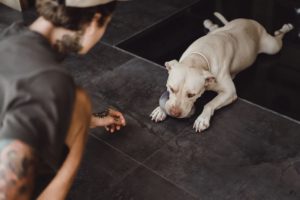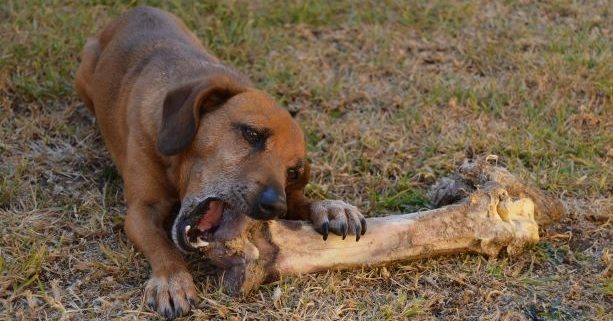Ask Crystal: Guarding Treats
Welcome to “Ask Crystal,” where you can ask your pet behavior questions! You can submit your question for Crystal at the bottom of the page!

Hey Crystal,
I adopted a Rottweiler puppy which is now 1 year old.
Recently I have seen that whenever she’s with a bone piece, she ignores my commands, though she knows “drop it”, “leave” command. She even growls and if am determined to make her drop the piece, she eats up that piece. I want her to obey my command and be submissive. Kindly help.
Sincerely,
Gimme that bone
Dear Gimme,
This is a common question/concern that people have regarding their dogs. It is quite normal behavior for a dog to guard a valuable resource. That being said, it may not be a very desirable behavior for most owners. There are ways when a dog is a puppy to teach the dog that a human approaching while they have something is a good thing. I recommend everyone with a puppy practice tossing treats to the dog while they approach or walk by the dog who is chewing on something, eating something or playing with something. You can progress to trading the dog a yummy treat for the toy and then giving the toy back. The dog then learns it is a good thing to have a toy taken and that often it will be given back. They will be much more likely to allow you to take items happily if you have done that training with them.
There are two kinds of submissive behavior, active and passive. Active submissive behavior is usually a request for attention from the receiver. This includes licking, nuzzling, crouching, play bows and pretzeling. Passive submission is in response to a threat and the goal of the dog is for the person or other dog to go away. Dogs display this type of behavior when they are stressed, fearful, anxious or threatened. So, when a dog acts submissive in that way it is because they are afraid and want you to go away. A dog that is afraid may demonstrate aggressive behaviors. Growling is an aggressive behavior which means the dog wants you to give them space or go away. It will not work out well to try to force a dog that is growling at you. The dog learns that you won’t listen to a growl so they will escalate their behavior to snapping and then biting. Using force or aggression to remove the item will likely escalate the situation quickly so I highly recommend that you don’t try to forcibly take the item if possible.
My first question would be, why are you needing to remove the bone? Is it because the bone has broken and is unsafe? Be sure if you are giving her bones, they are not cooked as in bones from your meals. Bones can be raw or smoked. Cooked bones can splinter and can perforate a dog’s intestines. Chicken bones especially splinter so never give cooked chicken bones. Or is it a stolen item? If she is getting bones from the trash, I recommend putting a lid on your trash or putting it in another room with a door on it. If you are giving her the bones, you have a couple options. You can stop giving her bones or you can let her finish eating the bones without trying to remove them. You should be careful that you give her large bones that she can’t swallow or get stuck on her jaw.
A lot of people have an issue with the principal of a dog guarding an item. My concern with a dog guarding items is a question of safety. There are dogs that will only guard one thing and it is pretty easy to live with. You can choose to not give them that item, leave them alone when they have it or work on a desensitization and counter conditioning training protocol. My concern is generally more with dogs that are guarding a lot of different things. Dogs will guard anything they perceive as a resource. That might be a person, locations, beds, toys. I have even heard of rare cases of dogs guarding grass. The big safety concern is when the dog has something, and you don’t know they have anything, and they bite. I have heard of people getting bitten over a candy wrapper under the couch.
Dogs do what works for them. If you want a dog to listen to what you are asking them to do, they need a reason. I try to live a life of cooperation with my dogs. They listen most of the time because I reinforce them for the behaviors I like. I have noticed a lot of people teach their dog “drop it” or “leave it” but rarely reinforce the behavior with a treat. Or they may give treats initially but stop after they believe the dog knows a behavior. Even if the dog understands what the behavior is, if you don’t follow up with some sort of reinforcer, the behavior will fall off. Especially with behaviors such as leave it where you are almost always competing with something really valuable in the environment. I used “leave it” to get my dog to stop chasing the cat. As soon as I said, “leave it” he stopped in his tracks and happily ran over to me. That is the response you need and that is due to a lot of practice using food rewards.
You can always work on a desensitization and counter conditioning protocol if you would really like to work on the reason the dog feels the need to growl at you. I can give you an idea of what that looks like, but you should really hire a Certified Professional Dog Trainer if you want to work on this type of training. Most people need some guidance to know when to take the next steps.

First, you would need to stop giving her anything she guards. Most protocols start with low value items that the dog is not going to guard and get them to like of someone approaching and then eventually removing an item. Make an ascending list of items from least to most valuable. Start with least valuable item, give the dog the item and walk away. Come back and approach the dog and toss her a treat. Practice that until the dog seems very comfortable with your approach. Then ask the dog, “can I have that?” and trade her a treat while you remove the item. This way we give the dog a cue for removing items and give something better in exchange. Give the item back and repeat. This can take weeks to months to get your dog to feel comfortable. Work your way through the list of several items until you get to the guarded items. We should always be looking for the dog’s body language of stiffening, nose pointed towards the item, and the whites of the eyes showing. These signs precede bites and snaps and mean the dog is not comfortable. Check out the book, “Mine” by Jean Donaldson for more information on this protocol. Different trainers will approach it differently, but the idea is to change the dog’s emotional response to you approaching and removing items.
If the dog is only guarding that one item, the easiest solution would be to stop giving it to her or prevent access to stolen items if that is how she is accessing it. Then start tossing treats to her anytime you approach her with toys or food and work up to asking if you can have it and trading for a treat. I suggest that you give the toy back, so she knows that usually she is going to get the item back. I would also suggest going back to working on leave it with treats more until she can respond to you when she is excited about something. Many times, a dog can do a cue in a normal situation but hasn’t had enough training to perform in a highly distracting situation. I hope these tips are helpful and that you find a solution that works everyone.
Until next time,
Crystal
Want more training for your animal? Sign up now for the first session of 2020 Manners 101 classes here!







